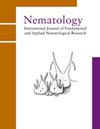黄河源区退化高寒草甸恢复斑块土壤线虫群落的变异
IF 1.1
4区 生物学
Q2 ZOOLOGY
引用次数: 0
摘要
准确测量土壤线虫群落对深入了解土壤线虫的生态功能具有重要意义。高通量测序(HTS)已被广泛报道,但HTS与形态学鉴定结果之间的一致性仍然缺乏。为了比较两种方法的差异,我们选取了3个样点不同恢复演替阶段的裸斑块(BP)、短期恢复斑块(SP)、中期恢复斑块(MP)和长期恢复斑块(LP)来调查线虫的特征。除线虫群落结构和群落生态功能外,采用HTS和形态鉴定两种方法对BP、SP、MP和LP的常见线虫属进行了比较。结果表明,与HTS相比,形态学分析鉴定出的物种数量较少。不同恢复斑块土壤线虫多样性为LP >MP比;SP祝辞英国石油公司。基于HTS的不同恢复斑块的Shannon-Wiener、Pielou、Simpson指数和物种数量反映了线虫群落的多样性,与形态学鉴定结果一致。在常见的线虫属中,Coslenchus、Aphelenchus和Leptonchus在两种方法中显示出显著的相关性。虽然这两种方法都有局限性,但在我们的研究结果中,HTS为快速了解黄河源区退化高寒草甸恢复斑块的土壤线虫生物多样性水平提供了一种更有效的方法。本文章由计算机程序翻译,如有差异,请以英文原文为准。
Variability in soil nematode communities across recovery patches in degraded Alpine meadows of the Yellow River source region
Summary Accurate measurements of soil nematode communities are important for an in-depth understanding of the ecological functions of soil nematodes. High throughput sequencing (HTS) has been reported extensively, but the concordance between HTS and morphological identification results is still lacking. To compare two methods, we selected bare patches (BP), short-term recovery patches (SP), middle-term recovery patches (MP) and long-term recovery patches (LP) of different restoration succession stages in three sample sites to survey the nematode characteristics. In addition to nematode community structure and community ecological function, common nematode genera in BP, SP, MP and LP were compared by two methods: HTS and morphological identification. The results show that the number of species identified in the morphological analysis was lower than using HTS. The soil nematode diversity in different recovery patches was LP > MP > SP > BP. The indices of Shannon-Wiener, Pielou, Simpson and species number of different recovery patches based on HTS reflected the biodiversity of nematode communities, which was consistent with the results of morphological identification. Of the common nematode genera, Coslenchus , Aphelenchus and Leptonchus showed a significant correlation by the two methods. Although both methods have limitations, the HTS provides a more effective means of observing soil nematode biodiversity levels for rapid insight across recovery patches in degraded alpine meadows of the Yellow River source region in our results.
求助全文
通过发布文献求助,成功后即可免费获取论文全文。
去求助
来源期刊

Nematology
生物-动物学
CiteScore
2.60
自引率
33.30%
发文量
67
审稿时长
3 months
期刊介绍:
Nematology is an international journal for the publication of all aspects of nematological research (with the exception of vertebrate parasitology), from molecular biology to field studies. Papers on nematode parasites of arthropods, and on soil free-living nematodes, and on interactions of these and other organisms, are particularly welcome. Research on fresh water and marine nematodes is also considered when the observations are of more general interest.
Nematology publishes full research papers, short communications, Forum articles (which permit an author to express a view on current or fundamental subjects), perspectives on nematology, and reviews of books and other media.
 求助内容:
求助内容: 应助结果提醒方式:
应助结果提醒方式:


